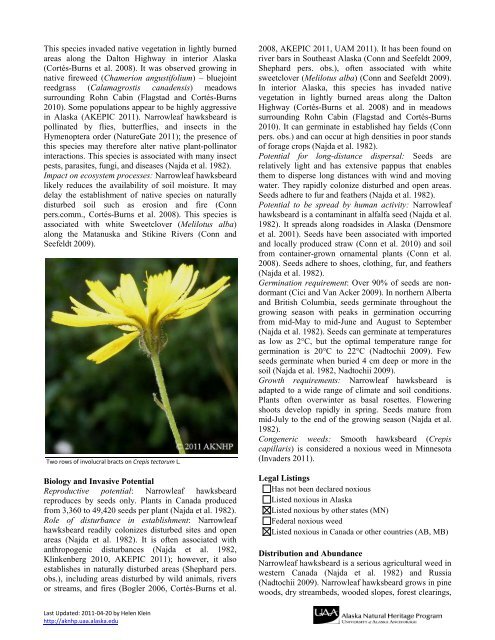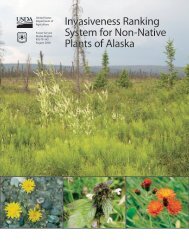narrowleaf hawksbeard Crepis tectorum L. - Alaska Natural Heritage ...
narrowleaf hawksbeard Crepis tectorum L. - Alaska Natural Heritage ...
narrowleaf hawksbeard Crepis tectorum L. - Alaska Natural Heritage ...
Create successful ePaper yourself
Turn your PDF publications into a flip-book with our unique Google optimized e-Paper software.
This species invaded native vegetation in lightly burnedareas along the Dalton Highway in interior <strong>Alaska</strong>(Cortés-Burns et al. 2008). It was observed growing innative fireweed (Chamerion angustifolium) – bluejointreedgrass (Calamagrostis canadensis) meadowssurrounding Rohn Cabin (Flagstad and Cortés-Burns2010). Some populations appear to be highly aggressivein <strong>Alaska</strong> (AKEPIC 2011). Narrowleaf <strong>hawksbeard</strong> ispollinated by flies, butterflies, and insects in theHymenoptera order (NatureGate 2011); the presence ofthis species may therefore alter native plant-pollinatorinteractions. This species is associated with many insectpests, parasites, fungi, and diseases (Najda et al. 1982).Impact on ecosystem processes: Narrowleaf <strong>hawksbeard</strong>likely reduces the availability of soil moisture. It maydelay the establishment of native species on naturallydisturbed soil such as erosion and fire (Connpers.comm., Cortés-Burns et al. 2008). This species isassociated with white Sweetclover (Melilotus alba)along the Matanuska and Stikine Rivers (Conn andSeefeldt 2009).Two rows of involucral bracts on <strong>Crepis</strong> <strong>tectorum</strong> L.Biology and Invasive PotentialReproductive potential: Narrowleaf <strong>hawksbeard</strong>reproduces by seeds only. Plants in Canada producedfrom 3,360 to 49,420 seeds per plant (Najda et al. 1982).Role of disturbance in establishment: Narrowleaf<strong>hawksbeard</strong> readily colonizes disturbed sites and openareas (Najda et al. 1982). It is often associated withanthropogenic disturbances (Najda et al. 1982,Klinkenberg 2010, AKEPIC 2011); however, it alsoestablishes in naturally disturbed areas (Shephard pers.obs.), including areas disturbed by wild animals, riversor streams, and fires (Bogler 2006, Cortés-Burns et al.2008, AKEPIC 2011, UAM 2011). It has been found onriver bars in Southeast <strong>Alaska</strong> (Conn and Seefeldt 2009,Shephard pers. obs.), often associated with whitesweetclover (Melilotus alba) (Conn and Seefeldt 2009).In interior <strong>Alaska</strong>, this species has invaded nativevegetation in lightly burned areas along the DaltonHighway (Cortés-Burns et al. 2008) and in meadowssurrounding Rohn Cabin (Flagstad and Cortés-Burns2010). It can germinate in established hay fields (Connpers. obs.) and can occur at high densities in poor standsof forage crops (Najda et al. 1982).Potential for long-distance dispersal: Seeds arerelatively light and has extensive pappus that enablesthem to disperse long distances with wind and movingwater. They rapidly colonize disturbed and open areas.Seeds adhere to fur and feathers (Najda et al. 1982).Potential to be spread by human activity: Narrowleaf<strong>hawksbeard</strong> is a contaminant in alfalfa seed (Najda et al.1982). It spreads along roadsides in <strong>Alaska</strong> (Densmoreet al. 2001). Seeds have been associated with importedand locally produced straw (Conn et al. 2010) and soilfrom container-grown ornamental plants (Conn et al.2008). Seeds adhere to shoes, clothing, fur, and feathers(Najda et al. 1982).Germination requirement: Over 90% of seeds are nondormant(Cici and Van Acker 2009). In northern Albertaand British Columbia, seeds germinate throughout thegrowing season with peaks in germination occurringfrom mid-May to mid-June and August to September(Najda et al. 1982). Seeds can germinate at temperaturesas low as 2°C, but the optimal temperature range forgermination is 20°C to 22°C (Nadtochii 2009). Fewseeds germinate when buried 4 cm deep or more in thesoil (Najda et al. 1982, Nadtochii 2009).Growth requirements: Narrowleaf <strong>hawksbeard</strong> isadapted to a wide range of climate and soil conditions.Plants often overwinter as basal rosettes. Floweringshoots develop rapidly in spring. Seeds mature frommid-July to the end of the growing season (Najda et al.1982).Congeneric weeds: Smooth <strong>hawksbeard</strong> (<strong>Crepis</strong>capillaris) is considered a noxious weed in Minnesota(Invaders 2011).Legal ListingsHas not been declared noxiousListed noxious in <strong>Alaska</strong>Listed noxious by other states (MN)Federal noxious weedListed noxious in Canada or other countries (AB, MB)Distribution and AbundanceNarrowleaf <strong>hawksbeard</strong> is a serious agricultural weed inwestern Canada (Najda et al. 1982) and Russia(Nadtochii 2009). Narrowleaf <strong>hawksbeard</strong> grows in pinewoods, dry streambeds, wooded slopes, forest clearings,Last Updated: 2011-04-20 by Helen Kleinhttp://aknhp.uaa.alaska.edu
















